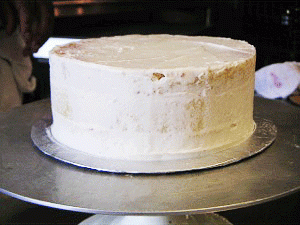 Now that the cake layers have been filled, they are crumb coated with a thin layer of frosting, in this case, buttercream. It is often described as a way to seal in the cake's crumbs so they won't get into the final coat of frosting, which follows, or the cake can be frozen with the crumb coat applied. Go to our Nouveau Christmas Fruitcake recipe where we show you how to crumb coat the cake, step-by-step.
Now that the cake layers have been filled, they are crumb coated with a thin layer of frosting, in this case, buttercream. It is often described as a way to seal in the cake's crumbs so they won't get into the final coat of frosting, which follows, or the cake can be frozen with the crumb coat applied. Go to our Nouveau Christmas Fruitcake recipe where we show you how to crumb coat the cake, step-by-step.
Crumb coating is also helpful when the cake is dark, such as a chocolate cake, and a lighter color frosting is placed on top, such as a white color buttercream frosting. The crumb coat provides an extra layer before the frosting layer is applied and helps prevent the dark underlying cake from showing through.
SARAH SAYS: I like to think of crumb coating as akin to the way spackling paste is used on a wall to prepare it for painting; a fine layer of spackling paste is used under the layer of paint to fill in the cracks and holes in the wall to smooth it's surface so the paint dries smoothly. A crumb coating of icing works the same way as spackling goes on a rough wall; it fills in the holes and cracks in the cake's surface so the next frosting layer goes on looking smooth and is ready for decorating on.
HOW TO TIPS:
1. Crumb Coat your cake with the same icing you are going to use for your final coat, except separate out a small portion of it to use just for this purpose. Toss out the crumb coating frosting portion afterwards because it may contain lots of crumbs.
2. Refrigerate your cake, uncovered, for 1/2 hour before applying the final frosting coat.
 SARAH SAYS: To apply and smooth the crumb coating, I use an offset icing spatula that is a little longer than the height of the cake I am working on. Since the cake is approximately 9-inches tall when filled, I use a 10-inch long icing spatula. That way I can smooth the frosting more effectively.
SARAH SAYS: To apply and smooth the crumb coating, I use an offset icing spatula that is a little longer than the height of the cake I am working on. Since the cake is approximately 9-inches tall when filled, I use a 10-inch long icing spatula. That way I can smooth the frosting more effectively.


